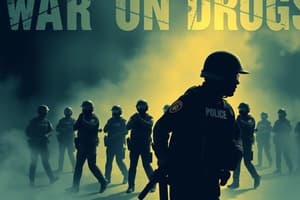Podcast
Questions and Answers
What was one of the key objectives of America’s War on Drugs when it began?
What was one of the key objectives of America’s War on Drugs when it began?
- To promote recreational drug use among citizens
- To curb drug use and end the drug trade (correct)
- To regulate the legal market for narcotics
- To increase the production of medicinal drugs
What act, passed in 1909, specifically targeted the recreational use of opium?
What act, passed in 1909, specifically targeted the recreational use of opium?
- Drug Enforcement Act
- Harrison Act
- Smoking Opium Exclusion Act (correct)
- Controlled Substances Act
Which president exploited fears of drug use among returning troops to gain support for his policies?
Which president exploited fears of drug use among returning troops to gain support for his policies?
- Richard Nixon (correct)
- Ronald Reagan
- Jimmy Carter
- Lyndon B. Johnson
By 1938, how many American doctors had been arraigned due to illegal drug prescriptions?
By 1938, how many American doctors had been arraigned due to illegal drug prescriptions?
What percentage of American adults reported trying cannabis in a 1969 Gallup poll?
What percentage of American adults reported trying cannabis in a 1969 Gallup poll?
The Controlled Substances Act of 1970 categorized drugs based on what criteria?
The Controlled Substances Act of 1970 categorized drugs based on what criteria?
What was a significant public perception about drug use in the 1960s?
What was a significant public perception about drug use in the 1960s?
What type of drugs did the Harrison Act of 1914 specifically regulate?
What type of drugs did the Harrison Act of 1914 specifically regulate?
Which narcotics were commonly marketed as cure-all medications in the mid-1880s?
Which narcotics were commonly marketed as cure-all medications in the mid-1880s?
What was the public's perception of drug-related issues leading up to the establishment of the War on Drugs?
What was the public's perception of drug-related issues leading up to the establishment of the War on Drugs?
What declaration did Nixon make regarding drug addiction in June 1971?
What declaration did Nixon make regarding drug addiction in June 1971?
What was one of the key legislative actions taken under President Reagan's administration in response to the drug crisis?
What was one of the key legislative actions taken under President Reagan's administration in response to the drug crisis?
How did the punitive measures of the War on Drugs disproportionately affect communities?
How did the punitive measures of the War on Drugs disproportionately affect communities?
What evidence suggests that incarceration has not effectively reduced drug consumption?
What evidence suggests that incarceration has not effectively reduced drug consumption?
What concept does harm reduction prioritize in drug policy?
What concept does harm reduction prioritize in drug policy?
What was a significant discrepancy in the sentencing laws for crack versus powder cocaine?
What was a significant discrepancy in the sentencing laws for crack versus powder cocaine?
What was the outcome of the Crime Bill passed during Bill Clinton's administration?
What was the outcome of the Crime Bill passed during Bill Clinton's administration?
Which demographic has been shown to be disproportionately affected by cannabis possession arrests?
Which demographic has been shown to be disproportionately affected by cannabis possession arrests?
What trend has emerged in the public’s perception of the War on Drugs in recent years?
What trend has emerged in the public’s perception of the War on Drugs in recent years?
Flashcards are hidden until you start studying
Study Notes
History of the War on Drugs
- The War on Drugs was officially declared in 1971 by President Nixon.
- The War on Drugs was designed to target drug use and smuggling in the United States.
- The war was largely a response to public fears of a drug epidemic, particularly concerning high rates of drug use among American troops returning from Vietnam.
- The Nixon administration viewed the drug war as a means to control the “antiwar left and black people.”
- President Ronald Reagan reinforced and expanded Nixon’s anti-drug policies in the 1980s.
- The 1986 Anti-Drug Abuse Act granted $1.7 billion for law enforcement to fight the drug war and implemented harsher mandatory minimum sentences for drug-related crimes.
- The Anti-Drug Abuse Act led to racial disparities in sentencing, for example, possession of five grams of crack cocaine (largely consumed by African Americans) carried a five-year jail sentence, while possession of 500 grams of powder cocaine (mostly consumed by white demographics) merited the same punishment.
- The War on Drugs has led to an increase in the incarceration rate of drug offenders, with drug-related offenses making up almost half of the federal prison population.
- The War on Drugs has disproportionately impacted people of color, with Black people being more than 3.5 times more likely to be arrested for cannabis possession than their White counterparts, despite both groups using the drug at similar rates..
Consequences of the War on Drugs
- The War on Drugs has perpetuated cycles of poverty and unemployment in low-income communities.
- The job market routinely discriminates against people with prior drug offenses.
- The War on Drugs has not been effective in reducing drug use.
- Studies have found no statistically significant correlation between drug imprisonment rates and the rate of drug use across most states.
- Only 11 percent of incarcerated individuals receive treatment for drug addiction, despite approximately 65 percent meeting the medical criteria for addiction.
Recent Developments
- There has been a growing movement towards decriminalization of drugs in the United States.
- 15 states have legalized recreational cannabis, and Oregon has decriminalized possession of small amounts of illegal drugs.
- Public support for ending the War on Drugs is growing; recent surveys indicate that 83 percent of Americans think it has failed and 66 percent of voters support eliminating criminal charges for drug possession.
Alternatives to the War on Drugs
- Harm reduction: Focuses on mitigating the negative impacts of drug use rather than criminalizing it.
- Harm reduction policies include evidence-based practices like syringe exchange programs, increased access to methadone clinics, and safe, supervised drug consumption spaces.
Solutions for Moving Forward
- Treat drug use and abuse as a public health crisis rather than a criminal issue.
- Overhaul the Drug Enforcement Agency (DEA).
- Remove criminal penalties for drug possession.
- Invest in programs that support treatment and recovery.
- Expunge criminal records related to drug offenses.
Studying That Suits You
Use AI to generate personalized quizzes and flashcards to suit your learning preferences.




